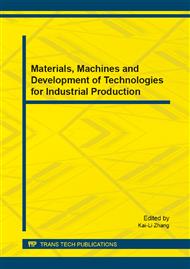[1]
Trouverie J, Chateau-Joubert S, Thévenot C, Jacquemot M. P and Prioul J. L. Regulation of vacuolar invertase by abscisic acid or glucose in leaves and roots from maize plantlets. Planta, 2004, 219(5): 894-905.
DOI: 10.1007/s00425-004-1289-3
Google Scholar
[2]
Proels R. K and Roitsch T. Extracellular invertase LIN6 of tomato: a pivotal enzyme for integration of metabolic, hormonal, and stress signals is regulated by a diurnal rhythm. Journal of Experimental Botany, 2009, 60(6): 1555-1567.
DOI: 10.1093/jxb/erp027
Google Scholar
[3]
Cheng Z, Kelian S, Joshua D. M, Alexander E. S, Rong J, Michael F. T and Shin-Han S. Cis-regulatory code of stress-responsive transcription in Arabidopsis thaliana. Proceedings of the National Academy of Sciences of the United States of America, 2011, 108(36): 14992-14997.
DOI: 10.1073/pnas.1103202108
Google Scholar
[4]
Yamasaki K, Kigawa T, Seki M, Shinozaki K and Yokoyama S. DNA-binding domains of plant-specific transcription factors: structure, function, and evolution. Trends in Plant Science, 2013, 18(5): 267-276.
DOI: 10.1016/j.tplants.2012.09.001
Google Scholar
[5]
Liu J, Zheng Q, Ma Q, Gadidasu KK and Zhang P. Cassava genetic transformation and its application in breeding. Journal of Integrative Plant Biology, 2011, 53 (7): 552-569.
DOI: 10.1111/j.1744-7909.2011.01048.x
Google Scholar
[6]
Ceballos H, Iglesias A, Perez C and Dixon G. Cassava breeding: opportunities and challenges. Plant Molecular Biology, 2004, 56: 503-516.
DOI: 10.1007/s11103-004-5010-5
Google Scholar
[7]
Yongbin Ou, Botao Song, Xun Liu, Conghua Xie, Meng Li, Yuan Lin, Huiling Zhang and Jun Liu. Promoter regions of potato vacuolar invertase gene in response to sugars and hormones. Plant Physiology and Biochemistry, 2013, 69: 9-16.
DOI: 10.1016/j.plaphy.2013.04.015
Google Scholar
[8]
Jacobo Arango, Bertha Salazar, Ralf Welsch, Felipe Sarmiento, Peter Beyer and Salim Al-Babili. Putative storage root specific promoters from cassava and yam: cloning and evaluation in transgenic carrots as a model system. Plant Cell Report, 2010, 29: 651-659.
DOI: 10.1007/s00299-010-0851-7
Google Scholar
[9]
Zou C, Sun K, Mackaluso JD, Seddon AE, Jin R, Thomashow MF and Shiu SH. Cis-regulatory code of stress-responsive transcription in Arabidopsis thaliana. Proceedings of the National Academy of Sciences of the United States of America, 2011, 108 (36): 14992-14997.
DOI: 10.1073/pnas.1103202108
Google Scholar


